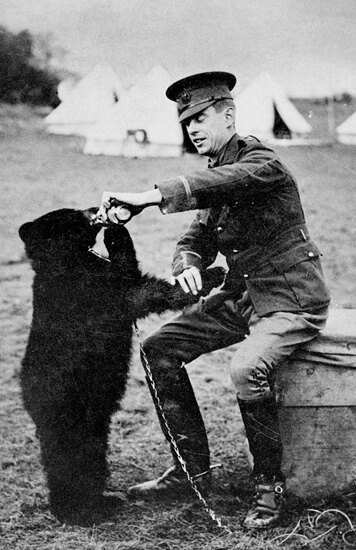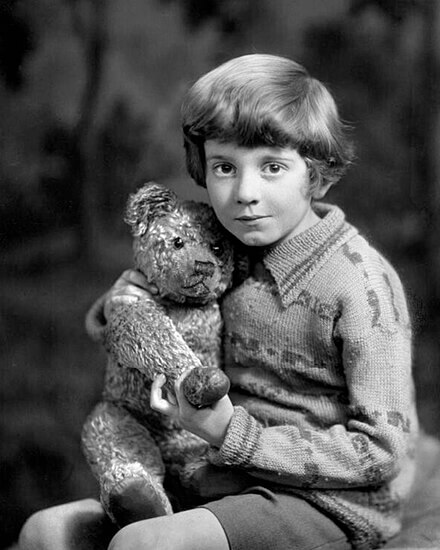
Lieutenant Harry Colebourn and Winnie, 1914.
[Wikimedia]
The teddy bear, gifted to him by his parents, became a beloved companion called Edward. Its name, however, was destined to change in 1924 when the boy, aged around four, saw the real thing at London Zoo with his father.
There, he met Winnie, a tame female black bear long accustomed to human contact since her earliest days in the Canadian wilderness. Inspired and enamoured, Christopher Robin rechristened his Teddy in her honour.
Additionally, the stuffed toy acquired the second name of “Pooh” after a moniker he had bestowed upon a previously encountered swan.
Winnie-the-Pooh had in practice, if not yet on paper, been born.
Nevertheless, the story began much earlier and further away in the Canadian lumber town of White River, Ont., on Aug. 24, 1914—almost exactly seven years before Christopher Robin laid eyes on his first birthday present.
En route to First World War battlefields via the training grounds of Valcartier, Que., British-Canadian soldier Lieutenant Harry Colebourn—originally of the 34th Fort Garry Horse, but attached to the Canadian Army Veterinary Corps (CAVC)—disembarked his troop train for some much-needed fresh air.
The steam cleared to reveal a solitary trapper with a black bear cub tethered to a bench armrest. Something stirred within the 27-year-old veterinarian officer, who felt compelled to inquire about the adolescent animal.
Colebourn learned that the trapper had killed the cub’s mother and was hopeful of selling the only survivor of a twin pair. Offering the hefty sum of $20, the lieutenant purchased her, and together, they reboarded the departing train.

Christopher Robin Milne in 1928 with the Teddy Bear that would help inspire the Winnie-The-Pooh stories. [Wikimedia]
Winnie had captured the hearts of the British people—not least the children around whom she maintained her calm and tender nature.
Winnie, as she would be called after Colebourn’s adopted hometown of Winnipeg, became an instant hit at Valcartier. When the CAVC contingent departed for England within the Second Canadian Infantry Brigade, the bear’s playful antics and growing love for her parental figure endeared her to the men.
And the pair bonded even more during the several weeks spent training on Britain’s Salisbury Plain. Winnie, often treated to condensed milk and apples, was reported to sleep under Colebourn’s tent cot at night. She also, perhaps unsurprisingly, became the main subject of many group photos.
But the realities of conflict soon became evident. On Dec. 9, 1914, Coulbourn found Winnie a new home, intended to be temporary, at London Zoo as he and his comrades prepared for imminent deployment to the Western Front.
The recently promoted captain—primarily tasked with caring for sick and wounded horses—witnessed horrors against man and creature alike.
At the Second Battle of Ypres, he wrote in his diary on April 22, 1915: “Town is being shelled to pieces…. Shell bursts almost at my feet. Germans gas French soldiers who retreat en mass [sic]. Hundreds of civilians [and] soldiers streaming down road. Terrible scenes. Canadian soldiers hold on grimly against great odds.”
Around two years later—on April 8, 1917—he recorded: “Easter Sunday and Eve of great offensive. Great Preparations. Heavy bombardments.”
Despite the seemingly ceaseless work under immense pressure, Colebourn visited Winnie whenever he could. While the CAVC officer had at least one narrow escape from a shell exploding mere yards away, his black bear companion likewise remained at risk from air raids over London.
Following the Nov. 11, 1918, armistice, the unlikely couple reunited. Aside from having matured considerably, Winnie had captured the hearts of the British people—not least the children around whom she maintained her calm and tender nature.
On Dec. 1, 1919, Winnie was officially donated to the zoo.
Colebourn stayed in England for a short period to further his veterinary studies. He subsequently moved back to Winnipeg, opened a private practice specializing in horses, and later took on a role at the Manitoba Department of Agriculture, where he had been employed prior to the war. In 1923, he married Christina McLeod and had one child, Fred, two years later. He also continued his service within The Fort Garry Horse, reaching the rank of major.
Of course, when Harry met Winnie, he could never have known what would transpire from a chance encounter on a northern Ontario train platform. Had he not purchased a black bear cub for $20 and had that animal not found residence in London Zoo, the world may have been deprived of one of its greatest gifts.

Winnie the Bear as a cub with a Canadian Army Veterinary Corps sergeant. [Wikimedia]
Winnie’s legacy prevails through memorials on both sides of the Atlantic.
On Oct. 14, 1926, inspired by his son’s imaginative mind, A.A. Milne—having already penned the verse When We Were Very Young two years previous—published a children’s book titled Winnie-the-Pooh. Illustrated by E.H. Shepard, the story became an internationally celebrated classic.
The best-selling books Now We Are Six (1927) and The House at Pooh Corner (1928) followed, as did a plethora of film and television adaptions.
Winnie, in many respects the original Silly Old Bear, lived out the rest of her days delighting fans on a global scale. Even in her advancing years, she never lost her love for human companionship and care. She died on May 12, 1934, at the respectable age of 20, her passing making news around the world.
Major Harry Colebourn himself died on Sept. 24, 1947, after suffering a fall at his home from which he didn’t recover. He was just 60 years old.
Yet his and Winnie’s legacy prevails through memorials on both sides of the Atlantic. From London Zoo to Winnipeg’s Assiniboine Park to White River, Ont., where it all started, Canadians and Britons have long since showcased their shared pride in a heartwarming tale borne of a heartbreaking war.
Above all else, the stories of A.A. Milne, unceasing in their ability to enthral across generations, stand testament to a friendship unlike any other.
Advertisement



















